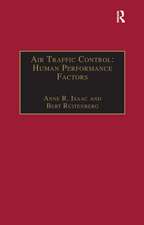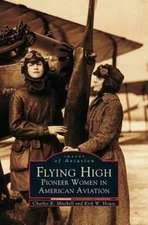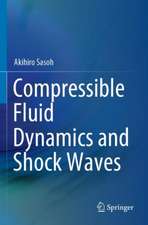31st International Symposium on Shock Waves 2: Applications
Editat de Akihiro Sasoh, Toshiyuki Aoki, Masahide Katayamaen Limba Engleză Hardback – 3 apr 2019
Chapter “Effects of Liquid Impurity on Laser-Induced Gas Breakdown in Quiescent Gas: Experimental and Numerical Investigations” is available open access under a Creative Commons Attribution 4.0 International License at link.springer.com.
Preț: 1888.27 lei
Preț vechi: 2484.56 lei
-24% Nou
Puncte Express: 2832
Preț estimativ în valută:
361.37€ • 375.88$ • 298.33£
361.37€ • 375.88$ • 298.33£
Carte tipărită la comandă
Livrare economică 10-16 aprilie
Preluare comenzi: 021 569.72.76
Specificații
ISBN-13: 9783319910161
ISBN-10: 3319910167
Pagini: 1340
Ilustrații: XX, 1186 p. 833 illus., 581 illus. in color. In 2 volumes, not available separately.
Dimensiuni: 155 x 235 mm
Greutate: 2.04 kg
Ediția:1st ed. 2019
Editura: Springer International Publishing
Colecția Springer
Locul publicării:Cham, Switzerland
ISBN-10: 3319910167
Pagini: 1340
Ilustrații: XX, 1186 p. 833 illus., 581 illus. in color. In 2 volumes, not available separately.
Dimensiuni: 155 x 235 mm
Greutate: 2.04 kg
Ediția:1st ed. 2019
Editura: Springer International Publishing
Colecția Springer
Locul publicării:Cham, Switzerland
Cuprins
Chapter1.Strength and Frequency of Underwater Shock Waves Related to Sterilization Effects on a Marine Bacterium.- Chapter2.Effects of Liquid Impurity on Laser-Induced Gas Breakdown in Quiescent Gas: Experimental and Numerical Investigations.- Chapter3.Air Blast from a Structural Reactive Material Solid.- Chapter5.Experimental study on Configuration Effects of Supersonic Projectiles in Transitional Ballistic Regimes.- Chapter6.Non-Ideal Blast Waves from Particle-Laden Explosives.- Chapter7.Attenuation of Blast Wave in a Duct with Expansion Region (Effects of configuration, porous panel, and acoustic material).- Chapter8.Enhancement of Deflagration-to-Detonation Transition Process with Energetic Solid Particle.- Chapter9.Large Scale Computation of Direct Initiation of Cylindrical Detonations.- Chapter10.Numerical Study on a Cycle of Liquid Pulse Detonation Engines.- Chapter11.Experimental investigate on the flame-shock wave interaction and pressure oscillation in a confined combustion chamber.- Chapter12.The Influence of Spatial Heterogeneity in Energetic Material on Non-ideal Detonation Propagation.- Chapter13.Detonation Experiment Research of Gaseous Mixtures with Suspended Metal Particles.- Chapter14.Large Eddy Simulation of Mixing Characteristic in the Cold Rotating-Detonation Chamber.- Chapter15.Research on the Continuous Rotating Detonation Wave in a Hollow Chamber with Laval Nozzle.- Chapter16.Experimental Study on a Long Duration Operation of a Rotating Detonation Engine.- Chapter17.Decaying modes of propagation of spinning detonation and flame front in narrow channel.- Chapter18.Measurement of gaseous fuel concentration in rotating detonation engines.- Chapter19.Investigation of High-Frequency Pulse Detonation Cycle with Fuel Phase Transition.- Chapter20.Simulations of Hydrogen Detonation in Vibrational Non-equilibrium .- Chapter21.Aerodynamic Force Measurement in a Large-Scale Shock Tunnel.- Chapter22.Trial Implementation of TiN Surface Coating for a Main Piston Towards Reducing the Opening Time for a Diaphragmless Driver Section.- Chapter23.Aerodynamic Force Measurement Techniques in JF12 Shock Tunnel .- Chapter24.Optimising the X3R Reflected Shock Tunnel Free-Piston Driver for Long Duration Test Times.- Chapter25.Development and Analysis of an Apollo Earth Re-entry Condition with Representative Post-shock Reynolds Number in the X2 Expansion Tunnel.- Chapter26.Liquid-Coupled Dual Piston Driver for Small-Scale Shock Tubes.- Chapter27.Initial testing of a 2m Mach-10 free piston Shock tunnel at CAAA.- Chapter28.CFD Evaluation and Experiment test of the Running time of the Hypersonic Ludwieg Tube Quiet Wind Tunnel.- Chapter29.Development and Performance Study of Shock Tube with Extended Test-times for Materials Research.- Chapter30.Measurement of Temperature Field around Spiked Bodies at Hypersonic Mach Numbers.- Chapter31.Three-dimensional Laser Interferometric CT density measurement of unsteady flow field around a cylinder induced by discharged shock wave from a cylindrical nozzle.- Chapter32.Curved shock wave propagation in environmental stratosphere by laser ablation.- Chapter33.Hypervelocity tests with a detonation driven expansion tube.- Chapter34.Experiments in HEG related to sonic line and shock stand-off distance on capsule shapes.- Chapter35.Catalytic Recombination Characteristics of Atomic Oxygen on Material Surfaces by Optical Emission Spectroscopy.- Chapter36.Influence of Dual Ignition on Test Conditions of a High Enthalpy Shock Tunnel.- Chapter37.Ablation Measurements in A Low Density Heat Shield Using Ablation Sensor Unit.- Chapter38.The Development of High Enthalpy Reentry Conditions in the X3 Expansion Tube.- Chapter39.Prediction of Intensity Profiles behind a Shock Wave Travelling in Air at Speeds Exceeding 12 km/s.- Chapter40.Revisiting temperature measurements at the focus of spherically converging shocks in argon.- Chapter41.Influence of Matrix Resin on Impact Resistance of CFRP by a SmallSphere.- Chapter42.Improvement of Impact Resistance of Ceramics by using Resin-based Materials.- Chapter43.Measurement of Plasma Formed by High-speed Impact to Estimate Temperature at Impact Point.- Chapter44.Application of Riemann Solver for Compressible and Non-Expanding Fluid to Impact on Regolith.- Chapter45.Mathematical modeling of the impact of high-speed metallic plates.- Chapter46.Study of Shock Impact Pressure Amplification and Attenuation of Acoustic Waves in E-Glass Material.- Chapter47.Reconstruction of Recoilless Weapon Blast Environments Using High-fidelity Simulations.- Chapter48.Contribution of Cavitation Generation to Shock Wave Sterilization Effects in a Narrow Water Chamber.- Chapter49.Shockwaves confer immunity against infections in mice.- Chapter50.On the relation between the shock wave thickness in bio-materials and the threshold for blast induced neuro-trauma.- Chapter51.Development of a miniaturized focused shock wave generator for medical application.- Chapter52.Intracellular Ca2+ Increase Evoked by Single Acoustic Pulses.- Chapter53.A new device for crossing chronic total occlusions.- Chapter54.Medical application of shock waves: Developing the treatment application and understanding of injury.- Chapter55.Towards non-invasive insulin injection via control of the electrical breakdown in liquid.- Chapter56.Current Trend in Cell Membrane Manipulation by Ultrasound and Underwater Shock Wave.- Chapter57.Analysis of Deformation Process of a Bubble in an Elastic Capsule by Shock Waves and Their Medical and Biological Applications.- Chapter58.Shockwaves can cure biofilm infections in-vivo in combination with antibiotics.- Chapter60.Simulation of shock-bubbles interaction using a four-equation homogeneous model.- Chapter61.A Study of Dispersion, Vaporization, and Combustion of Burnable Liquids Surrounding Charges.- Chapter62.Multi-scale simulation of the interaction of a shock wave and a cloud of particles.- Chapter63.Surface Jetting Induced by Explosion in Liquid below an Immersed Bubble.- Chapter64.Generation Frequency of Rebound Shock Waves from Bubble Collapses in Cavitation Jet.- Chapter65.Experimental Study on the Influence of Underwater Explosion Depth on the Disintegration of Thin Resin Plate Attached Microbubbles.- Chapter66.Numerical Study of the Flow Separation in a Rocket Nozzle.- Chapter67.Hybrid RANS/LES simulation of shock-induced separated flow in truncated ideal contour nozzle.- Chapter68.Experimental Study of TICTOP Nozzles.- Chapter69.Three-Dimensional Instability of Shock-Wave/Boundary- Layer Interaction for Rocket Engine Nozzle Applications.- Chapter70.Shock interactions in Thrust Optimized Parabolic (TOP) Nozzles during Start-Up and Shut Down.- Chapter71.Shock System Deformation in High Mach Number Rocket Nozzles.- Chapter72.Interaction of Droplets with Incident Shock Waves.- Chapter73.A compact finite volume method for computing shock waves on hybrid grids.- Chapter74.Numerical Modelling of the Effects ofSurface Roughness on Blunt Body Heat Transfer..- Chapter75.Numerical study of shock propagation in liquid/gas media.- Chapter76.CFD models of shocks and flow fields associated with decelerating spheres in terms of flow history and inertial effects.- Chapter77.Conjugate Heat Transfer Analysis in a Hypersonic Flow.- Chapter78.Laser-induced shock waves in micro tubes.- Chapter79.Study of MHD Effects in the High-Enthalpy Shock Tunnel G?ttingen (HEG) using a 30T Pulsed Magnet System .- Chapter80.An Electrodynamic Aerobraking Experiment in a Rarefied Arc-Heated Flow.- Chapter81.Blast Wave Propagation Affected by Ground Characteristics.- Chapter82.Multiple reflected shock wave in closed volume with granular screen.- Chapter83.Some aspects of the numerical modeling of shock wave ? dense particles bed interaction using two-fluid approach.- Chapter84.To the complex approach to the numerical investigation of the shock wave - dense particles bed interaction.- Chapter85.Numerical Study on Shock Wave Reflection over a Double Wedge in Dusty Gas.- Chapter86.Shock and Blast Wave Interaction With Hard Sand Pan.- Chapter87.Long time history of unsteady drag on shock accelerated micro-particles.- Chapter88.Shock Focusing Effect upon Interaction of a Shock with Low-Density Dust Cloud.- Chapter89.Shock-induced motion of a spherical particle floating in air.- Chapter90.Exploring the capability of a new shock tube facility to investigate shock interaction with inert particle columns.- Chapter91.MITIGATION OF BLAST IN A WATER MIST.- Chapter92.Shock wave propagation through a series of perforated plates.- Chapter93.Experimental Investigation of Strong Shock Heated Gases Interacting with Materials in Powder form.- Chapter94.Selective shock-refraction properties in non-ideal fluids.- Chapter95.A Numerical Investigation of Oblique Shock Waves in Non-Ideal Compressible-Fluid Flows.- Chapter96.Assessment of real gas effects on SCO2 flows with shock waves.- Chapter97.Structure of shock waves in noble gases under high density conditions..- Chapter98.Mach 4 Shock Train Structures in Rectangular Ducts.- Chapter99.Control of Shock Trains within Supersonic Intakes through the addition of Cavities.- Chapter100.Experiments in Supersonic Gaseous Ejector using 2D PIV Technique.- Chapter101.Numerical analysis of surface heat flux in a forward facing cavity.- Chapter102.Large Eddy Simulation of Expansion Wave Diffraction.- Chapter103.In-pipe aerodynamic characteristics of a projectile in comparison with free-flight for transonic Mach numbers between 0.5 and 1.5.- Chapter104.Experimental Investigation of Shock Wave Characteristics in Small Scale Circular Channel.- Chapter105.Shock Oscillation Studies with Varying Stagnation Pressure in a Supersonic Diffuser.- Chapter106.Measurement of shock wave attenuation in microchannels.- Chapter107.Surface jets produced from an underwater shock wave.- Chapter108.Pressure sensors for hostile environments .- Chapter109.Visualization of inception, propagation and collapse process of underwater positive streamer.- Chapter110.Optimisation and design of a fully instrumented Mach 12 nozzle for the X3 expansion tube.- Chapter111.Heat-Flux Measurement of Flat Delta-Plate using Phosphor Thermography Technique in Gun Tunnel.- Chapter112.Hypersonic Boundary Layer Tripping to Turbulence on a Conical Body.- Chapter113.Hypersonic Flow Simulations by Applying an Equivalent Gas Model.- Chapter114.DNS of Hypersonic Corner Flow on a Supercomputer.- Chapter115.The role of three-dimensional shock wave interaction in the complex hypersonic heating.- Chapter116.Numerical Simulation of Effect of Angle-of-Attack on a Supersonic Parachute System.- Chapter117.Experimental Study of High-Altitude Simulation for Space Launch Vehicles.- Chapter118.Characteristics of Self-Sustained-Shock Pulsation around a Forward-Facing Concave with Spike.- Chapter119.Free Flight Experiment Investigation of AOA Effect on Cone Boundary Layer Transition at Mach 6.- Chapter120.Review on Film Cooling in Supersonic Flow.- Chapter121.Measurement and Calculation of Shock Stand-off Distances over Hypersonic Spheres in CO2.- Chapter122.Prediction of Stagnation-Point Radiative Heating for FIRE II.- Chapter123.Characterisation of Curved Axisymmetric Internal Shock Waves.- Chapter124.Comparative Heat Flux Measurement of a Sharp Cone between Three Hypersonic Test Facilities at LHD.- Chapter125.Near-Field Pressure Signature over Mach 1.7 Free-Flight Bodies.- Chapter126.Experimental Study of Radiation behind Reflected Air Shock Waves.- Chapter127.Flow-field for an Accelerating Axisymmetric Body.- Chapter128.Modeling of 1-DOF Launch dynamics in transonic and supersonic regime using Navier Stokes Equation.- Chapter129.Skin friction measurement based on SSLCCs in hypersonic wind tunnel.- Chapter130.Thermo-structural Design of Sharp Leading Edges for hypersonic vehicles using Finite element modelling.- Chapter131.Computational Study on Rigid Disk-Gap-Band Supersonic Parachute Aerodynamics.- Chapter132.Numerical Estimation of Laser-Ablation Propulsion Performance in Supersonic Flight for Donut-Mode Laser Guided Spherical Capsule Launch System.- Chapter133.Investigation of the Heat transfer over Spike Blunt Bodies in Hypersonic.- Chapter134.Numerical Investigation on the Effects of Air Dissociation upon Hypersonic Projectile in Standard Atmospheric Air.- Chapter135.Shockwave Oscillation under Critical Starting Mach Number in Hypersonic inlet.- Chapter136.Numerical analysis of transonic buffet on a three-dimensional wing.- Chapter137.Critical Condition of Bow-Shock Instability around Edged Blunt Body.- Chapter138.Experimental study on hypersonic pitch-up anomaly in shock tunnel.- Chapter139.Pressure Measurements around an Electric Discharge Produced on a Wedge in a Supersonic Flow.- Chapter140.Thermal Spike Conception for Wave Drag Reduction of Blunt Bodies at Different Supersonic Speeds.- Chapter141.Experimental investigations of a diffuser start/unstart characteristics for two stream supersonic wind tunnels..- Chapter142.Experimental investigation of film cooling technique over a blunt body in hypersonic flow.- Chapter143.Wavefront Aberration in a Laser Beam Induced by Supersonic Flow Field Around a Wedge.- Chapter144.Boundary layer transition measurements on sharp and blunt cones in the T4 Stalker Tube.- Chapter145.Estimation of the Particle Drag Coefficients for Compressible and Rarefied Flows Using PIV and MTV Data.- Chapter146.RANS simulation of over-and under-expanded beveled nozzle jets using OpenFOAM.- Chapter147.Exploration of under-expanded free and impinging supersonic jet flows.- Chapter148.PIV studies on the effect of number of lobes in a supersonic ESTS lobed nozzle.- Chapter149.Numerical Study of Heat Transfer on Confined Under-expanded Impinging Jet from Slot into A Plenum.
Recenzii
Notă biografică
Textul de pe ultima copertă
This is the second volume of a two volume set which presents the results of the 31st International Symposium on Shock Waves (ISSW31), held in Nagoya, Japan in 2017. It was organized with support from the International Shock Wave Institute (ISWI), Shock Wave Research Society of Japan, School of Engineering of Nagoya University, and other societies, organizations, governments and industry. The ISSW31 focused on the following areas: Blast waves, chemical reacting flows, chemical kinetics, detonation and combustion, ignition, facilities, diagnostics, flow visualization, spectroscopy, numerical methods, shock waves in rarefied flows, shock waves in dense gases, shock waves in liquids, shock waves in solids, impact and compaction, supersonic jet, multiphase flow, plasmas, magnetohyrdrodynamics, propulsion, shock waves in internal flows, pseudo-shock wave and shock train, nozzle flow, re-entry gasdynamics, shock waves in space, Richtmyer-Meshkov instability, shock/boundary layer interaction,shock/vortex interaction, shock wave reflection/interaction, shock wave interaction with dusty media, shock wave interaction with granular media, shock wave interaction with porous media, shock wave interaction with obstacles, supersonic and hypersonic flows, sonic boom, shock wave focusing, safety against shock loading, shock waves for material processing, shock-like phenomena, and shock wave education. These proceedings contain the papers presented at the symposium and serve as a reference for the participants of the ISSW 31 and individuals interested in these fields.
Chapter “Effects of Liquid Impurity on Laser-Induced Gas Breakdown in Quiescent Gas: Experimental and Numerical Investigations” is available open access under a Creative Commons Attribution 4.0 International License via link.springer.com.
















